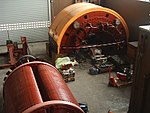Railway power converter plant
As traction substation , also Power Works , refers to a electro-mechanical system with rotating electric machines for converting electrical energy from the public electricity grid (50 Hz) in traction power (16.7 Hz) for the electrical supply of rail vehicles. In a traction current converter plant there are converters that carry out the conversion by means of an electric motor and electric generator .
Until the 1920s, all systems for supplying railways whose operating current did not match the type of current, frequency and number of phases of the supplying network were traction current converter plants. Since the 1920s, direct current railways have been fed via rectifiers (initially mercury vapor rectifiers, now silicon rectifiers practically everywhere).
For the supply of railways with single-phase alternating current of reduced frequency , as in Germany , Austria , Switzerland , Norway and Sweden , mostly combinations of a three-phase asynchronous motor and a generator for single-phase alternating current are used. In addition, come HVDC - Quick couplings are used.
Traction power converter plants can be used decentrally (conversion of public electricity into traction current directly on the railway lines, no feed into a traction current network) as well as centrally (conversion to supply the traction current network, thus to supply the overhead lines of adjacent lines). Central traction current converter plants can be found in Germany (including in Borken / Hessen , Dresden , Chemnitz , Harburg , Lehrte , Karlsruhe , Neckarwestheim , Nuremberg , Saarbrücken , Neu-Ulm ), Austria and Switzerland.
Decentralized traction current converter plants for traction power supply are used in Norway , Sweden , Mecklenburg-Western Pomerania , Berlin , Brandenburg and parts of Thuringia and Saxony-Anhalt . To supply DC-powered trains are since the 1920s with rectifiers equipped substations used.
Converter units are increasingly being replaced by converter units that perform the same function using converters based on power electronics . Converters offer the advantage over converters that in the event of a short short circuit, the machine does not fail directly. For this reason, not all converter plants can be replaced.
Open motor of the E1 machine in the converter plant in Karlsruhe during repair work. The carbon brushes rest against the thickening of the shaft during operation .
Generator rotor with fan blade and exposed shaft .





